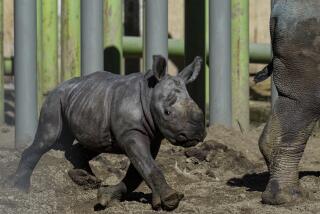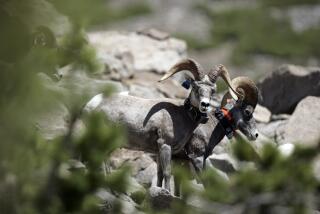Surge in rhino poaching devastates African populations
Reporting from Limpopo Province, South Africa — The baby rhino, an orphan, had barely been weaned. Her horn was only a few inches long. But that didn’t stop the poachers from hacking it off.
David Uys, 33, had helped raise the rhino after her mother was killed by lightning. He called her Weerkind -- “orphan” in Afrikaans. He won’t forget the sight of the bodies of the baby and two other rhinos, shot dead, their horns removed.
“I’m not a one for talking about emotions,” Uys said quietly. “But it was like seeing one of your family members dead, the brutality of it.”
The slain bull rhino, dubbed Longhorn, was about 35 and had a magnificent horn more than 2 1/2 feet long. The third rhino, Sister, had adopted Weerkind after her mother was killed. The three died together in November on this Limpopo province game ranch that is for tourists, not hunters, north of Pretoria.
“You’re angry. You’re furious. You’re sad. You’re crying,” said Uys, the ranch manager. “Just a bundle of emotions, bursting inside.”
A sharp surge in poaching in South Africa and Zimbabwe by organized gangs has devastated Zimbabwe’s rhino population and threatens to wipe out South Africa’s critically endangered black rhinos within a decade. South African rancher Pelham Jones warns that the more common white rhino won’t be far behind unless something is done.
A report last year by the World Wildlife Fund, the International Union for Conservation of Nature and wildlife-trade monitoring network TRAFFIC said poaching had reached a 15-year high, pushing the animals close to extinction. About 1,500 rhino horns were traded illegally in the last three years, despite a long-standing ban on international trade.
Last year, 122 rhinos were killed in South Africa. Jones predicted that at the current poaching rate, 180 to 200 will be killed this year. A provisional 2009 estimate shows only 800 rhinos remaining in Zimbabwe, and 18,553 white and 1,570 black rhinos in South Africa, according to the Convention on International Trade in Endangered Species of Wild Fauna and Flora, or CITES, which maintains the ban on the trade of rhino horn.
Rhino ranchers, some of whom keep the animals to attract tourists while others rely on limited trophy hunting, are so wary about the involvement of organized crime in rhino killings that few are willing to talk publicly for fear of endangering animals on their properties. Interviews are given on condition that properties, even nearby towns, are not identified.
The ranch where Weerkind was born and killed is a lush green in the summer rainy season, with rocky hills looming into the sky. Birds with impossibly long tails seem weighed down in flight as they flutter near a pond. A red track cuts uphill through the acacia trees. Rain clouds gather, thunder grumbles, and a sudden drenching rain pours down, stopping abruptly half an hour later.
Up close, the rhinos look benign, almost bovine, ambling in the Limpopo sunshine, plucking grass, shadowed by a group of guards in camouflage carrying semiautomatics. Their small, thick-lashed eyes look sleepily docile. But their sheer size is awesome -- a rhino is almost as big as a car, weighing from 2,000 to 3,000 pounds. From a few yards away, they are terrifying.
Not for Uys, even though he’s been charged countless times and once was knocked over and walked on. Afterward, he recalled, the bull looked almost apologetic.
Uys has spent his life with rhinos. At 18, he was a rhino guard, sleeping in the bush with them through violent summer thunderstorms and harsh winter nights.
“I was close enough to scratch their ears. They took me as part of the group.”
When he did get charged, it was usually his own fault for getting too close, he says.
“Running away is the worst thing you can do,” he said. “You can’t outrun a rhino.” If there’s a tree or boulder, you scramble up. If there’s thick enough bush, you stand your ground.
Once, photographing a newborn baby, he and a colleague were suddenly approached by the calf. The two men froze. If the mother saw them and charged, there was no bush, no trees, no boulders.
“They react to movement so if you stand completely still, they won’t see you,” Uys said. “The guy who was with me, his nerves didn’t hold out, and he started running. The cow saw us and she came for us.”
There was no time to think.
“I threw down my backpack. She smelled me there and took her fury out on the backpack,” he said. It was one of his closest calls.
If you called Uys a rhino whisperer, he’d be offended by the cliche. But he does have a gift with the creatures.
The other day, he crouched low about 20 yards away from a male rhino named Benni, trying to get a look at his slightly injured foot. Another rhino, Bettie, suddenly ambled right up to him. Any sharp move would be disastrous. When she got close enough to nuzzle, he raised his hand. He pressed a fist gently just under her horn. Surprised, she wandered off to graze.
Game rancher Jones, who leads an action group of rhino owners to combat poaching, said incidents are reported every other day.
His phone beeps constantly with text messages alerting him to poaching incidents and sightings of suspected poachers.
“There’s another one,” he said, grabbing his phone.
The police, he said, are little help. In one recent case, they arrived four days after a group of rhinos was killed. In another, a police officer picked up an ax abandoned by the poachers, destroying any fingerprints.
The South African government disbanded the police force’s endangered-species unit in 2003. The government last year promised to bring back a special-investigations unit -- but critics believe it’s not enough to make a difference.
“This is our cultural heritage,” Jones said. “People come to South Africa to see the Big Five, not the Big Four,” he added, a reference to South Africa’s five biggest wildlife draws: rhinos, elephants, lions, leopards and cape buffalo.
China’s recent thrust into Africa in a rush for resources is a major factor in the illegal rhino horn and ivory trade, analysts believe, because China remains the largest market. Rhino horn, made of keratin, the same substance that forms fingernails, hooves, feathers and hair, has long been used in Chinese medicinal tonics.
Zimbabwe’s collapse added to the problem, with corrupt government, army and wildlife officials reportedly involved in poaching and smuggling rhino horn and ivory. The airport in that country’s capital, Harare, is reportedly a key transit hub.
In South Africa, Vietnamese diplomatic officials have allegedly been involved in rhino horn buying and smuggling. Reports in Vietnam that a government official was “cured” of cancer by rhino horn appear to have spurred Asian demand.
Many fear that the Asian market is so ancient and entrenched, there’s not much a small group of farmers can do to save the species. Some support the idea of rhino farming -- regularly pruning horns, which grow back -- to meet the demand and drive down prices. Others argue that legalizing the trade would only fuel demand, putting the creatures at even more risk. After the killings of the baby rhino and two adults, Uys put his energies into Benni and Bettie. Benni, more unpredictable than Longhorn, sometimes charges unexpectedly. Bettie is docile and sweet. Uys worries about their survival almost as if they were his children, just as he once worried about Weerkind and her family.
“Longhorn and Weerkind and Sister were my passion. But since they have been poached, I have devoted all my time to [Benni and Bettie]. And now I think I love them just as much as I loved the others.”
How to help: The Endangered Wildlife Trust ( www.ewt.org.za) is working to improve the protection of rhinos in southern Africa.
More to Read
Sign up for Essential California
The most important California stories and recommendations in your inbox every morning.
You may occasionally receive promotional content from the Los Angeles Times.










